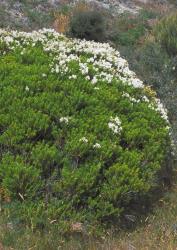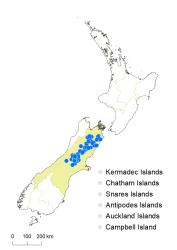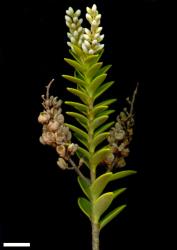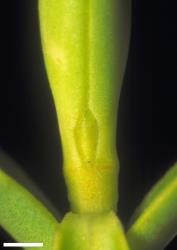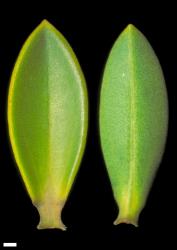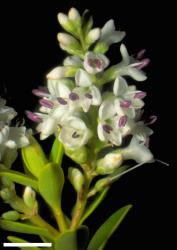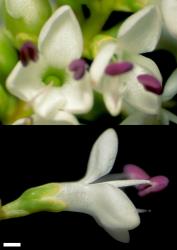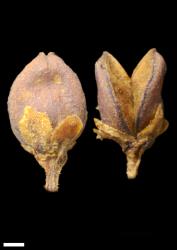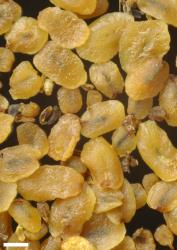- ≡ Veronica traversii Hook.f., Curtis’s Botanical Magazine 104, Plate 6390 (1878) nom. illeg., non Veronica traversii Hook.f. 1864
- ≡ Hebe brachysiphon Summerh., Kew Bull. 1927: 397 (1927)
Bushy and often rounded shrub, to 1.8 m tall. Stems erect; eglandular-pubescent with minute glandular hairs; hairs usually bifarious, sometimes uniform. Leaf bud distinct, its leaves appressed at margins until fully grown; sinus narrow, acute. Leaves opposite-decussate to weakly sub-distichous, erecto-patent to spreading; lamina sub-coriaceous to rigid, ovate to obovate, usually elliptic, or sometimes oblanceolate or oblong, 5.5–25.5 mm long, 3.3–10.0 mm wide, usually more or less glossy or sometimes dull light to dark green above, paler and duller beneath; midrib and sometimes two lateral veins evident; surfaces glabrous except for eglandular hairs along midrib above; margin eglandular- and/or glandular-ciliolate when young, becoming minutely papillate with age, entire; apex sub-acute to obtuse, mostly acute, keeled beneath and weakly apiculate; base cuneate; petiole 0.5–3.5 mm long. Inflorescence a lateral raceme or sometimes ternate, 12–41 mm long; flowers crowded, 9–36, female or bisexual on separate plants, ⚥ > ♀; bracts alternate or the lowest opposite, lanceolate to ovate or narrowly deltoid, ≥ pedicels; pedicels erecto-patent, 0.6–3.0 mm long, eglandular-hairy all around or sometimes almost glabrous. Calyx lobes 4–5 (5th small, posterior), obtuse to sub-acute, occasionally emarginate, 1.9–3.0 mm long, equal or sub-equal, glandular- or mixed glandular- and eglandular-ciliolate. Corolla 6–8 mm diameter; tube white, 1.6–4.0 mm long, > calyx, eglandular-hairy inside; lobes 4, white or sometimes pale purplish, erecto-patent to spreading, sub-equal, usually elliptic to ovate, sometimes oblong, obovate, or orbicular; nectar guides absent. Stamen filaments white, 1.0–4.5 mm long; anthers magenta to purplish. Style glabrous, 4.2–7.2 mm long. Capsules latiseptate, sub-acute, usually glabrous or rarely eglandular hairy, 3–6 mm long, 2.3–4.5 mm at widest point. Seeds ellipsoid to oblong, flattened, weakly wrinkled and undulate at margin, pale brown to brown, 0.8–2.8 mm long.
odora | mooreae | pauciramosa | masoniae | venustula | brachysiphon | |
|---|---|---|---|---|---|---|
Leaf bud sinus | broad, shield-shaped | narrow & acute to broad & shield shaped | broad, shield-shaped | broad, shield-shaped | narrow, acute | narrow, acute |
Leaf margin | sharply bevelled; glabrous | bevelled at 90º to surfaces, glabrous | rounded; glabrous or with minute hairs or denticles | rounded, papillate towards apex; ciliolate when young | weakly bevelled; ciliolate when young, becoming glabrous or papillate | weakly bevelled; ciliolate to ciliate when young, becoming papillate |
Stomata | adaxial – (but often + at Arthur’s Pass); abaxial + | adaxial – (+ at Caswell Sound, Denniston); abaxial + | adaxial +; abaxial + | adaxial +; abaxial + | adaxial ±; abaxial + | adaxial ±; abaxial + |
Midrib | sharply keeled beneath | depressed above; prominent beneath | rounded beneath and flattened just short of apex | keeled throughout | evident but not keeled | evident but not keeled |
Inflorescence | terminal + usually lateral spikes | lateral spikes only | lateral spikes only | terminal spikes only | lateral raceme, sometimes ternate, rarely compound. | lateral raceme, sometimes ternate. |
Bracts | not overtopping calyx | < calyx | < calyx | ≥ calyx | ≥ pedicels, < calyx | ≥ pedicels, < calyx |
Bracts and flowers | opposite | opposite | opposite | opposite | opposite below, becoming alternate | alternate, or lowermost opposite |
Pedicels | 0 mm | 0–1 mm | 0–0.5 mm | 0 mm | 0.5–7.0 mm | 0.6–3.0 mm |
Calyx, anterior lobes | free | free or fused to ⅓-way | fused > ⅔-way | free | free | free |
Corolla lobes | narrow | broad | narrow | broad | ± broad | ± broad |
South Island: Sounds Nelson (Red Hills Range), Marlborough, Canterbury, Westland, from the Main Divide to the eastern foothills, reaching a southern limit near Mt Hutt.
Montane to sub-alpine tussock grassland and scrub and in beech forest close to tree line. Recorded elevations range from 600 to 1605 m.
The difficulty in distinguishing V. brachysiphon from V. subfulvida might be due to introgression.
Flowers: October–March; fruits: January–May, persisting until December.
2n = 120 (see Bayly & Kellow 2006, as Hebe brachysiphon).
Veronica brachysiphon is classified in V. subg. Pseudoveronica sect. Hebe and the informal group “Apertae” (small-leaved) (Albach & Meudt 2010; Bayly & Kellow 2006).
The seed description above is based on very few specimens and might understate the variability.



